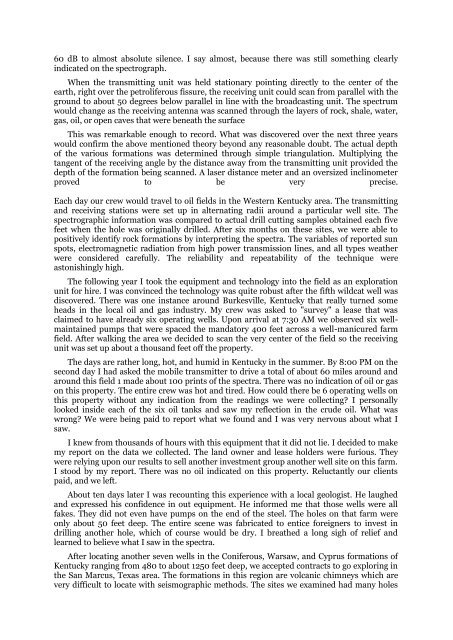ANGELS DON‘T PLAY THIS HAARP Advances in Tesla Technology
ANGELS DON‘T PLAY THIS HAARP Advances in Tesla Technology
ANGELS DON‘T PLAY THIS HAARP Advances in Tesla Technology
Create successful ePaper yourself
Turn your PDF publications into a flip-book with our unique Google optimized e-Paper software.
60 dB to almost absolute silence. I say almost, because there was still someth<strong>in</strong>g clearly<br />
<strong>in</strong>dicated on the spectrograph.<br />
When the transmitt<strong>in</strong>g unit was held stationary po<strong>in</strong>t<strong>in</strong>g directly to the center of the<br />
earth, right over the petroliferous fissure, the receiv<strong>in</strong>g unit could scan from parallel with the<br />
ground to about 50 degrees below parallel <strong>in</strong> l<strong>in</strong>e with the broadcast<strong>in</strong>g unit. The spectrum<br />
would change as the receiv<strong>in</strong>g antenna was scanned through the layers of rock, shale, water,<br />
gas, oil, or open caves that were beneath the surface<br />
This was remarkable enough to record. What was discovered over the next three years<br />
would confirm the above mentioned theory beyond any reasonable doubt. The actual depth<br />
of the various formations was determ<strong>in</strong>ed through simple triangulation. Multiply<strong>in</strong>g the<br />
tangent of the receiv<strong>in</strong>g angle by the distance away from the transmitt<strong>in</strong>g unit provided the<br />
depth of the formation be<strong>in</strong>g scanned. A laser distance meter and an oversized <strong>in</strong>cl<strong>in</strong>ometer<br />
proved to be very precise.<br />
Each day our crew would travel to oil fields <strong>in</strong> the Western Kentucky area. The transmitt<strong>in</strong>g<br />
and receiv<strong>in</strong>g stations were set up <strong>in</strong> alternat<strong>in</strong>g radii around a particular well site. The<br />
spectrographic <strong>in</strong>formation was compared to actual drill cutt<strong>in</strong>g samples obta<strong>in</strong>ed each five<br />
feet when the hole was orig<strong>in</strong>ally drilled. After six months on these sites, we were able to<br />
positively identify rock formations by <strong>in</strong>terpret<strong>in</strong>g the spectra. The variables of reported sun<br />
spots, electromagnetic radiation from high power transmission l<strong>in</strong>es, and all types weather<br />
were considered carefully. The reliability and repeatability of the technique were<br />
astonish<strong>in</strong>gly high.<br />
The follow<strong>in</strong>g year I took the equipment and technology <strong>in</strong>to the field as an exploration<br />
unit for hire. I was conv<strong>in</strong>ced the technology was quite robust after the fifth wildcat well was<br />
discovered. There was one <strong>in</strong>stance around Burkesville, Kentucky that really turned some<br />
heads <strong>in</strong> the local oil and gas <strong>in</strong>dustry. My crew was asked to "survey" a lease that was<br />
claimed to have already six operat<strong>in</strong>g wells. Upon arrival at 7:30 AM we observed six wellma<strong>in</strong>ta<strong>in</strong>ed<br />
pumps that were spaced the mandatory 400 feet across a well-manicured farm<br />
field. After walk<strong>in</strong>g the area we decided to scan the very center of the field so the receiv<strong>in</strong>g<br />
unit was set up about a thousand feet off the property.<br />
The days are rather long, hot, and humid <strong>in</strong> Kentucky <strong>in</strong> the summer. By 8:00 PM on the<br />
second day I had asked the mobile transmitter to drive a total of about 60 miles around and<br />
around this field 1 made about 100 pr<strong>in</strong>ts of the spectra. There was no <strong>in</strong>dication of oil or gas<br />
on this property. The entire crew was hot and tired. How could there be 6 operat<strong>in</strong>g wells on<br />
this property without any <strong>in</strong>dication from the read<strong>in</strong>gs we were collect<strong>in</strong>g? I personally<br />
looked <strong>in</strong>side each of the six oil tanks and saw my reflection <strong>in</strong> the crude oil. What was<br />
wrong? We were be<strong>in</strong>g paid to report what we found and I was very nervous about what I<br />
saw.<br />
I knew from thousands of hours with this equipment that it did not lie. I decided to make<br />
my report on the data we collected. The land owner and lease holders were furious. They<br />
were rely<strong>in</strong>g upon our results to sell another <strong>in</strong>vestment group another well site on this farm.<br />
I stood by my report. There was no oil <strong>in</strong>dicated on this property. Reluctantly our clients<br />
paid, and we left.<br />
About ten days later I was recount<strong>in</strong>g this experience with a local geologist. He laughed<br />
and expressed his confidence <strong>in</strong> out equipment. He <strong>in</strong>formed me that those wells were all<br />
fakes. They did not even have pumps on the end of the steel. The holes on that farm were<br />
only about 50 feet deep. The entire scene was fabricated to entice foreigners to <strong>in</strong>vest <strong>in</strong><br />
drill<strong>in</strong>g another hole, which of course would be dry. I breathed a long sigh of relief and<br />
learned to believe what I saw <strong>in</strong> the spectra.<br />
After locat<strong>in</strong>g another seven wells <strong>in</strong> the Coniferous, Warsaw, and Cyprus formations of<br />
Kentucky rang<strong>in</strong>g from 480 to about 1250 feet deep, we accepted contracts to go explor<strong>in</strong>g <strong>in</strong><br />
the San Marcus, Texas area. The formations <strong>in</strong> this region are volcanic chimneys which are<br />
very difficult to locate with seismographic methods. The sites we exam<strong>in</strong>ed had many holes


